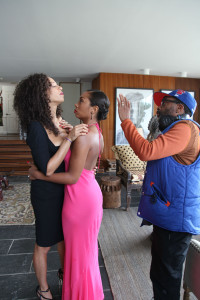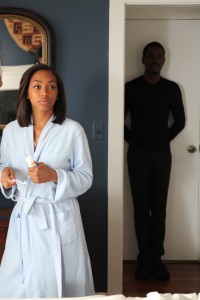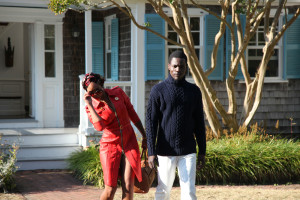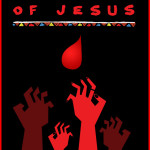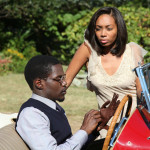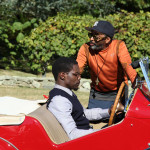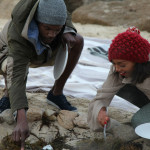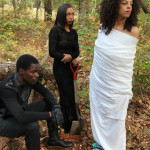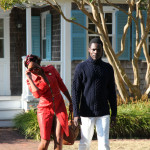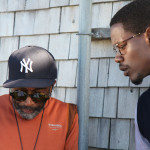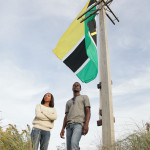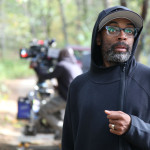Exclusive: Director Spike Lee, Zaraah Abrahams Talk ‘Da Sweet Blood of Jesus’
Exclusive: Director Spike Lee, Zaraah Abrahams Talk ‘Da Sweet Blood of Jesus’
Posted by Brad Balfour
Posted by Brad Balfour
February 11, 2015
New York filmmaker Spike Lee has become one of most important voices of African American cinema since he released his first feature in 1986, She’s Gotta Have It. As a reflection of his own generation of indie filmmakers, he made this film on his own terms, shooting it in familiar friendly locations, casting friends, family and himself, with a storyline that strove more for the emotional impact rather than Hollywood slickness.
The 57-year-old Brooklynite has been telling stories that resonates honestly with his core audience — not worrying about whether his work would be marketable beyond it — hoping to develop audiences based on the fact that he told tales with honesty and authenticity.
So in keeping with Spike’s core experience and roots, he turned to the crowd-funding Kickstarter and his extensive fan base to finance his latest film, Da Sweet Blood of Jesus — one that was not likely to garner Hollywood-style financing. Through this effort, the diminutive director has done a re-imagining of Bill Gunn’s classic cult horror filmGanja an Hess, on his own terms without producers or studios interfering.
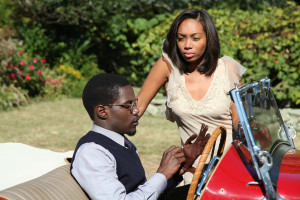
Reinterpreting Gunn’s unappreciated film, Lee’s production is a kind of love story, a story of a twisted addiction — to blood — that destroyed an ancient African tribe and threatens to destroy this duo of Ganja Lafayette (Zaraah Abraham) and Hess Green (Stephen Tyrone Williams).
Introduced to a cursed ritual knife by art curator Lafayette Hightower (Elvis Nolasco), Green weirdly develops the need for human blood regardless of the consequences. Though he’s not really a vampire, the film suggests he becomes immortal and can pass on that attribute to someone else — in this case, Ganja — who also shares a sexual passion with him as well.
Actress Zaraah Abrahams, a relatively fresh face from England, has a whole different history and experience from American actors. She lends a certain exoticism and allure to her character that emerges the second her accent is heard.
Both Spike and Zaraah answered questions regarding this unusual film in this exclusive interview held at Spike’s 40 Acres and A Mule Filmworks office in Brooklyn.
How did Spike find you and how did you find Spike and respond?
Zaraah Abrahams: I shot a short film for one of Spike’s students called “Black Girl in Paris” and he was a mentor to her. So when she showed the film in postproduction, that’s when he saw me in her film and he was asked for my details, saying “I got a project that I think that she’ll be good for”.
So he emailed me and I didn’t believe it was him and I didn’t reply! Then he called and we spoke and he told me he would fly to London. We then further spoke about the script, and I did a casting in London and four days later he flew me out to New York for a screen test and I got the role.
One important thing about the movie is that it’s about stepping out of history, because when you become an immortal you step out of history and are able to see all of history. Did you see the film in terms of history as an element of the story? Of course history is very important to the black filmmaking experience — did you reflect back on your own history as well?
Spike Lee: We have the film as part of the legacy of Bill Gunn — a great, great filmmaker, playwright and director. This film is a child of Ganja & Hess.
ZA: It certainly was the case for me because, like Spike said, Kay Lee captured so much of what was very representative of the Ashanti culture. For me to even go into that house [in Martha’s Vineyard] and look at things that were so symbolic and meant so much to history made me think about the things that I would like to capture and things that have been captured in my personal history.
How much did you decide to move the mythology around that’s part of the original film and how much did you keep that mythology in place?
SL: It’s all choices, you know. I just felt that I always aimed to be better. It was shot up the Hudson [and Martha’s Vineyard]… That area is so beautiful that I wanted to shoot it there. There’s been a vibrant African American community there since the 1950s.
When you were researching the objects that you were going to have in the film, were there ones that had a certain significance to you, like the ritual killing knife or some of the sculptures?
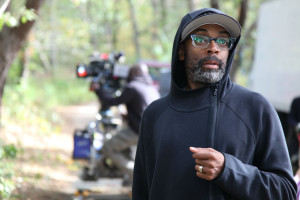 SL: Not specifically. Bu that was the most important thing about the film. We did a lot of running around to get that right. It was made — we researched it, but we had that made.
SL: Not specifically. Bu that was the most important thing about the film. We did a lot of running around to get that right. It was made — we researched it, but we had that made.
One of the reason that vampires make others a vampire — not just a victim of their feeding — is so that they’re not alone. That’s always been an interesting psychological aspect of vampirism — and an aspect of this film which isn’t really like a traditional vampire movie.
SL: The film comes out of a Black exploitation era which was made a hundred percent to capitalize on the big hit of Scream, Blackula, Scream, and Bill Gunn decided to twist this around. When the producers saw the film, they had to first cut it up and release it with four different titles.
Thank God there’s one print which was rescued by the Museum of Modern Art. MOMA has the original print.
There are historical references in the film — in terms of the Ashanti mythology and artifacts for example — and it’s great how you used the mask and other artifacts as historical elements to inform the film and its context in history. What did you learn about the art, about that history and how did it inform you in making the film?
SL: Well, number one, anytime you do a film you have to do research, and a director has to do research; the production designers have to do research as well. The designer’s name is Kay Lee and she was wonderful.
Not all the work was specifically referencing Ashanti culture, but we got in as much as we could. The two most important things in Ashanti culture are the two stools: there’s the legend of a golden stool concerning a hundred years of the British trying to get it from them, which they never got. So those stools are Ashanti.

The rest is various African art, and since he’s a doctor, an African doctor, we wanted to reflect that in his home.
You hear about bloodletting and drinking of blood and you inevitably have certain expectations of vampirism. What expectations did you walk in with and how did Spike dispel your expectations as to how you were supposed to play this character?
ZA: He definitely wanted me to portray a strong black woman who has lots of layers and who had a rich history of her own. I think in a lot of films women tend to be a bit of a sad keeper, and he definitely wanted to reiterate the history.
The way Spike dispelled my vampire expectations was all because when I read the script, it was very prominent to me that it was about addiction. The love story made it even more apparent that he had a problem rather than the film being about a fantastical character–somebody who was sucking people’s blood — and because of the strength it takes to get through this journey of addiction.
I think when you have an addiction problem, you unconsciously become addicted to other things because they become your crutch and enable you to further your addiction. So we did start to become addicted to each other because we understood each other; which is how I think addiction works with other people. You just stay with people who have addiction similar to yours so you can understand what they’re going through.
That’s why I suppose he wanted me to become addicted to him as well, so we could understand each other on a different level. It’s in the script. It’s because he wants me to live forever; because he doesn’t want to be alone, and selfishly I think that’s what a lot of people do suffering from addiction.
Spike, are there any particular horror films or vampire films that you love or influenced by besides Gunn’s film?
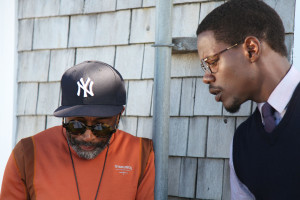 SL: I really try to refrain from putting my films in a genre. A lot of times I mixed things up, so I never thought of Ganga & Hess as a horror film, let alone with this film.
SL: I really try to refrain from putting my films in a genre. A lot of times I mixed things up, so I never thought of Ganga & Hess as a horror film, let alone with this film.
Duane Jones, the original Hess, was the key man in two of the most essential horror films of all time, the other being The Night of the Living Dead. That 1968 film was a genre bender in its own right. You take certain genre elements and take them outside of its boundaries. Is that a goal you try to accomplish?
SL: I just think genres are too limiting. I like to stretch things out a bit.
ZA: I think one of the most challenging things for me was to put across appropriately that the addiction of blood was JUST a metaphor for all the other addictions out there, and to try and translate that through the obsession with each other.
And for you Spike, was it hard to get your cast to do that without making it look conscious?
SL: Making any film is one of the hardest things known to man and woman, so every film has a challenge. You just have different challenges pertaining to the subject matter.
SL: No. When I did Inside Man, we screened Dog Day Afternoon two or three times. So it depends.
Was it difficult to to figure out a way to sell it to people when you did the Kickstarter campaign?
SL: Well I was in a dilemma because of Hollywood’s studio system and how they make trailers now: they put everything the movie’s about in the trailers, and that’s the worst thing to do.
But at the same time, I’m soliciting people for money too. So I was between a rock and a hard place because they want to know “So what’s it’s about!?” Thank God we were able to reach our goal, but a lot of people wanted to know the beginning, middle and end before they even gave you a nickel.
You seem to be a master at making films that are on a tight schedule. What is it that you’ve done with this film that made it worth shooting on a 16-day schedule?
SL: We have a very precise, well-oiled machine at 40 Acres and a Mule. We only work with great actors who know their lines and are not going to spend four hours in make up and hair, who can come to the set and do their job and go home at 6 o’clock.
Clip – Museum of the Republic of Brooklyn
Clip – They Meet




